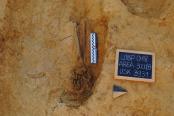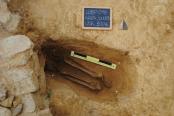CAMPAGNA 2018 |
1° SETTIMANA |
2° SETTIMANA |
3° SETTIMANA |
4° SETTIMANA |
5° SETTIMANA |
6° SETTIMANA |
7° SETTIMANA |
8° SETTIMANA |
9° SETTIMANA |
09 LUGLIO 2018 
Resoconto della giornata di scavo
Area 3000
Nella porzione settentrionale del Settore B è stata completata la messa in luce degli arti inferiori degli individui USK 3931 e USK 3904, entrambi intercettati da altri contesti. In particolare di USK 3931 si conserva solamente la tibia, la fibula ed il piede sinistro ed alcuni metatarsali del piede destro; il resto del corpo è stato tagliato da altre fosse sepolcrali di XI secolo e dal condotto di alimentazione della fornace postmedievale. Di USK 3904, orientato W-E a ridosso della facciata USM 3335, nella porzione nord-occidentale del settore, rimane parte delle ginocchia, le tibie ed i piedi, con le dita in parte sovrapposte. Il resto dello scheletro è stato intercettato dalla fossa di fondazione (US – 3738) della facciata di XII secolo. Nella porzione sud-occidentale del settore continua la messa in luce dell’inumato USK 3903, orientato W-E e deposto all’interno della fossa sepolcrale US – 3933. Prosegue inoltre l’indagine delle buche di forma circolare allineate fra loro e realizzate probabilmente per l’alloggiamento di pali per sostegno di una struttura lignea a pianta rettangolare.
Today we continued excavating the skeletons in the area. Two of the burials were photographed and were GIS pointed. Skeleton 3931 is in the process of being removed.
Area 5000
La pulizia del settore C dell'area 5000 situato nella porzione Sud, ha messo in luce la presenza di alcune buche di piccole dimensioni, dal diametro non superiore ai 10 cm, disposte lungo un arco di circonferenza. Per quanto sia difficile determinarne la loro funzione è possibile ipotizzare la presenza di una struttura di piccole dimensioni che testimonia l'attività umana in quest'area in un periodo precedente all'edificazione delle strutture abbaziali. Nei prossimi giorni saremo in grado di esplorare a fondo l'area per osservare ulteriori tracce di vita relative a questa zona del sito.
Today the students cleaned the southern portion of section C as well as the trench in preparation for pictures. After the pictures were taken, holes were dug in areas of soil discoloration.
Area 6000
Sono state definitivamente rimosse, previa documentazione fotografica e topografica, le sepolture USk 6218 (individuo adulto orientato ovest-est nella porzione orientale del settore sud) ed USk 6224, nell'angolo nord-est del medesimo settore (ossa superstiti erano gli arti inferiori, a causa della rimozione delle restanti in seguito alla costruzione della tomba a cassa USM 6062).
Today before lunch, several of us completed stratigraphic context sheets for the cuts and fills of burials 6218 and 6224 that included describing the consistency, color, and makeup of the soil. We learned that because cuts are actions in the soil, they do not have color or consistency. After lunch, two of us began removing the fill from burial 6228 where there is currently an exposed cranium. We were looking to see if this cranium was in articulation with the rest of the skeleton or was disarticulated. In Area 6220, we continued to expose the uncovered sections of the skeleton, in particular the right ribs, hand bones, and pelvis. On the skeleton’s left side, what is thought to be the other radius was found, such that the skeleton i more symmetrical. The left humerus was discovered in a strange position, as it was disconnected and on a lower level than the left forearm and right upper limb. This position suggests the possible presence of a slope or coffin. What was originally believed to be the left scapula is now thought to be part of a pelvis after being further exposed due to its large size and curvature. It is as yet unknown whether this pelvis belongs to another burial or is part of the fill; however, the former is unlikely as no lower limbs that could belong to the pelvis were found. We are continuing to excavate the upper part of the burial in search of the cranium. The questions that must now be answered are 1) where is the rest of the upper part of the skeleton, 2) where might the rest of the vertebrae be, and 3) will it lead to a skull that can be excavated and unearthed.












